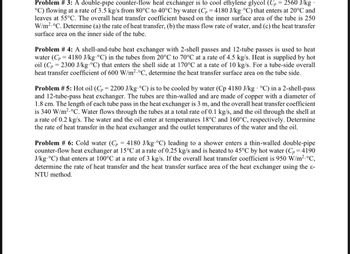
Elements Of Electromagnetics
7th Edition
ISBN: 9780190698614
Author: Sadiku, Matthew N. O.
Publisher: Oxford University Press
expand_more
expand_more
format_list_bulleted
Concept explainers
Question
I need the solution in hand writing

Transcribed Image Text:Problem # 3: A double-pipe counter-flow heat exchanger is to cool ethylene glycol (Cp = 2560 J/kg.
°C) flowing at a rate of 3.5 kg/s from 80°C to 40°C by water (Cp=4180 J/kg-°C) that enters at 20°C and
leaves at 55°C. The overall heat transfer coefficient based on the inner surface area of the tube is 250
W/m² °C. Determine (a) the rate of heat transfer, (b) the mass flow rate of water, and (c) the heat transfer
surface area on the inner side of the tube.
Problem # 4: A shell-and-tube heat exchanger with 2-shell passes and 12-tube passes is used to heat
water (Cp = 4180 J/kg-°C) in the tubes from 20°C to 70°C at a rate of 4.5 kg/s. Heat is supplied by hot
oil (Cp = 2300 J/kg °C) that enters the shell side at 170°C at a rate of 10 kg/s. For a tube-side overall
heat transfer coefficient of 600 W/m² °C, determine the heat transfer surface area on the tube side.
Problem # 5: Hot oil (Cp = 2200 J/kg-°C) is to be cooled by water (Cp 4180 J/kg °C) in a 2-shell-pass
and 12-tube-pass heat exchanger. The tubes are thin-walled and are made of copper with a diameter of
1.8 cm. The length of each tube pass in the heat exchanger is 3 m, and the overall heat transfer coefficient
is 340 W/m² °C. Water flows through the tubes at a total rate of 0.1 kg/s, and the oil through the shell at
a rate of 0.2 kg/s. The water and the oil enter at temperatures 18°C and 160°C, respectively. Determine
the rate of heat transfer in the heat exchanger and the outlet temperatures of the water and the oil.
Problem #6: Cold water (Cp = 4180 J/kg-°C) leading to a shower enters a thin-walled double-pipe
counter-flow heat exchanger at 15°C at a rate of 0.25 kg/s and is heated to 45°C by hot water (Cp=4190
J/kg.°C) that enters at 100°C at a rate of 3 kg/s. If the overall heat transfer coefficient is 950 W/m² °C,
determine the rate of heat transfer and the heat transfer surface area of the heat exchanger using the e-
NTU method.
Expert Solution
This question has been solved!
Explore an expertly crafted, step-by-step solution for a thorough understanding of key concepts.
This is a popular solution
Trending nowThis is a popular solution!
Step by stepSolved in 3 steps with 2 images

Knowledge Booster
Learn more about
Need a deep-dive on the concept behind this application? Look no further. Learn more about this topic, mechanical-engineering and related others by exploring similar questions and additional content below.Similar questions
- If you were manufacturing a precision component which has a mass of around 15 grams and which was a solid 3D shape, which method would be appropriate?arrow_forward1. Define manufacturing processes, design engineer, industrial engineer and materials engineer? 2. Name and explain a protess to make cylinder shaft? 3. Discus at least three factors which will effect tool life? 4. Define finishing and roughing process? 5. Explain the negative effect of heat generated from machining process? 6. One limitation of sand casting is bad surface finish. Yes or No? Why? 7. What is permeability in casting process? 8. What are the major defects in casting process? 9. Which type of casting process should be use for high melting point casting, such as cast iron and why? 10. Casting problem A certain mold has a sprue whose length is 20 cm and the cross-sectional area at the base of the sprue is 2.5 cm?. The sprue feeds a horizontal runner leading into a mold cavity whose volume is 1560 cm³. Determine: (a) velocity of the molten metal at the base of the sprue, (b) volume rate of flow, and (c) time to fill the mold (in second). mfg m1 Spring 2020 999.pptxarrow_forwardA control block costs $.75 per part to mill without a fixture and $.43 per part when a fixture is used. Assuming the cost of the fixture is $175.00, how much will the fixture save over a production run of 2200 parts?arrow_forward
Recommended textbooks for you
 Elements Of ElectromagneticsMechanical EngineeringISBN:9780190698614Author:Sadiku, Matthew N. O.Publisher:Oxford University Press
Elements Of ElectromagneticsMechanical EngineeringISBN:9780190698614Author:Sadiku, Matthew N. O.Publisher:Oxford University Press Mechanics of Materials (10th Edition)Mechanical EngineeringISBN:9780134319650Author:Russell C. HibbelerPublisher:PEARSON
Mechanics of Materials (10th Edition)Mechanical EngineeringISBN:9780134319650Author:Russell C. HibbelerPublisher:PEARSON Thermodynamics: An Engineering ApproachMechanical EngineeringISBN:9781259822674Author:Yunus A. Cengel Dr., Michael A. BolesPublisher:McGraw-Hill Education
Thermodynamics: An Engineering ApproachMechanical EngineeringISBN:9781259822674Author:Yunus A. Cengel Dr., Michael A. BolesPublisher:McGraw-Hill Education Control Systems EngineeringMechanical EngineeringISBN:9781118170519Author:Norman S. NisePublisher:WILEY
Control Systems EngineeringMechanical EngineeringISBN:9781118170519Author:Norman S. NisePublisher:WILEY Mechanics of Materials (MindTap Course List)Mechanical EngineeringISBN:9781337093347Author:Barry J. Goodno, James M. GerePublisher:Cengage Learning
Mechanics of Materials (MindTap Course List)Mechanical EngineeringISBN:9781337093347Author:Barry J. Goodno, James M. GerePublisher:Cengage Learning Engineering Mechanics: StaticsMechanical EngineeringISBN:9781118807330Author:James L. Meriam, L. G. Kraige, J. N. BoltonPublisher:WILEY
Engineering Mechanics: StaticsMechanical EngineeringISBN:9781118807330Author:James L. Meriam, L. G. Kraige, J. N. BoltonPublisher:WILEY

Elements Of Electromagnetics
Mechanical Engineering
ISBN:9780190698614
Author:Sadiku, Matthew N. O.
Publisher:Oxford University Press

Mechanics of Materials (10th Edition)
Mechanical Engineering
ISBN:9780134319650
Author:Russell C. Hibbeler
Publisher:PEARSON

Thermodynamics: An Engineering Approach
Mechanical Engineering
ISBN:9781259822674
Author:Yunus A. Cengel Dr., Michael A. Boles
Publisher:McGraw-Hill Education

Control Systems Engineering
Mechanical Engineering
ISBN:9781118170519
Author:Norman S. Nise
Publisher:WILEY

Mechanics of Materials (MindTap Course List)
Mechanical Engineering
ISBN:9781337093347
Author:Barry J. Goodno, James M. Gere
Publisher:Cengage Learning

Engineering Mechanics: Statics
Mechanical Engineering
ISBN:9781118807330
Author:James L. Meriam, L. G. Kraige, J. N. Bolton
Publisher:WILEY